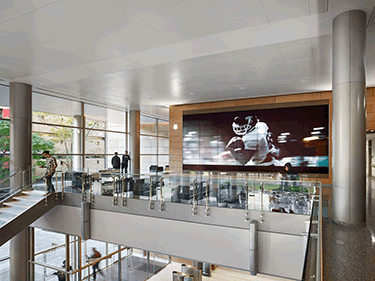Temple University recently opened The Science Education and Research Center (SERC) to establish the university as a center of excellence in scientific education and research. The Science Education and Research Center is one of the largest buildings devoted exclusively to scientific research in the Philadelphia region. The seven-story structure includes fifty-two research labs and sixteen teaching labs, open spaces to foster collaboration, and high-tech equipment such as clean rooms and a low-vibration scanning tunneling microscope facility.
Temple University recently opened The Science Education and Research Center (SERC) as part of a key strategy to further establish the university as a center of excellence in scientific education and research.
Also among SERC's high technology assets is a sophisticated digital video wall in the building's main lobby that is comprised of thirty-five large (55-inch) displays (Generation 2 of the Planar Clarity Matrix LCD video wall system). These displays present a variety of informational, educational, and entertainment content from sources that are managed by Planar's VCS. They represent the vanguard of a system to extend teaching and learning onto large-scale display platforms—in SERC as well as in other facilities on campus—that transform how everything from science to art is presented to students, shared among faculty and staff, and enjoyed by visitors.
“The Planar video wall is clearly a ‘wow’ factor," said Larry Brandolph, associate vice president of computer services for Temple University. “But it also sets the tone for the building and will help attract talented scholars and students seeking opportunities for the highest level of exploration and investigation.”
- The Clarity Matrix product was recommended to Brandolph and his Temple team by Total Video Products of Mickleton, New Jersey. With the available wall space on the mezzanine level of the lobby, it was determined that a seven by five array of the Clarity displays (Model MX55HDS) would provide the platform best suited to the needs and interests of Brandolph, his information services organization, and the other university constituents involved In the decision-making process.
